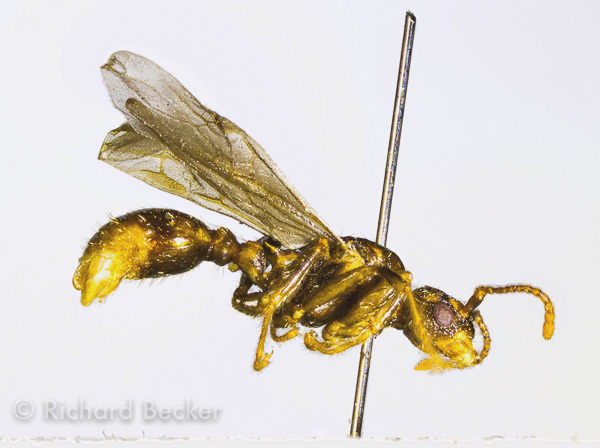17 Mar 2017
While the evenings are still dark and cold I have been looking back through some ant specimens I took last year. Looking at a supposedly male Myrmica sabuleti I found under a stone a Roundton Hill I was surprised to see it had some characteristics of a female, as well as male genitalia.
I first decided to look at again as it stood out as being slightly larger and paler than other male Myrmica ants I have seen. Under a microscope the colours appeared distinctly patchy, which is unusual, I then noticed it has spines on the propodeum, which no male should have. Looking more closely I realised the the antennae, although the normal shape of a male M. sabuleti had the 12 segments of a female rather than 13 of a male. When examined closely some parts of the cuticle have the strongly rugose (ridged) surface of the female, others the relatively smooth surface of the male. Eventually I came to the conclusion that what I have is a mosaic gynandromorph, a view confirmed after an email exchange with the national ant expert.

Gynandromorphs, where part of the animal is male and part female are well known in insects. Most often reported are bilateral gynandromorphs where one side of the insect is male the other female. These are most striking in butterflies and moths with sexual dimorphism, the male side for example can have blue wings, the female brown. Mosaic gynandromorphs are even odder and are mainly a feature of Hymenoptera, especially ants it seems. The name ‘jigsaw ant’ may have been coined by Derek Wragge Morley who included a chapter on an Irish island where numerous examples had been found in his book ‘The Ant world’ (Pelican 1953).
I have tried to research how these bizarre animals come about, though there seem to be a lot of possible causes, and each time I look I find another one or more. Bilateral gynandromorphs where the animal is half and half, and examples where a quarter of the animal is the opposite sex, seem to have a different origin to mosaics, and can be produced experimentally.
While some authors suggest a genetic origin for mosaics, most point to one of two possible causes, both related to the unusual haplodiploid sex determination of hymenoptera. In one theory the egg will have been fertilised by two sperm, one which joins with the egg nucleus, the other remaining as a ‘spare’ nucleus within the cell. Then at various points during the development of the embryo instead of the nuclei splitting during cell division one whole nucleus goes to each of the new cells. The part of the embryo receiving the fertilised (diploid) nucleus then develops as female, the part with the unfertilised (haploid) nucleus developing as male.
The alternative theory is that the ant is a result of a mating between a normal queen ant and a diploid male resulting in a triploid offspring. This happens occasionally in hymenoptera, particularly as a result of inbreeding. If an embryo from a fertilised egg has two identical copies of the sex determining gene it will develop as male rather than female as it should. As male hymenoptera pass on all their genetic material in sperm any resulting offspring will be triploid. The sex of different parts of the animal may then be different as different parts receive differing combinations of the three sets of chromosomes during cell division.
Whatever the origin, gynandromorphs can be a bit weird, but interesting. Mosaic ants it is suggested are found quite often because they remain in the nest after the rest of the alates have left, and are therefore noticed.